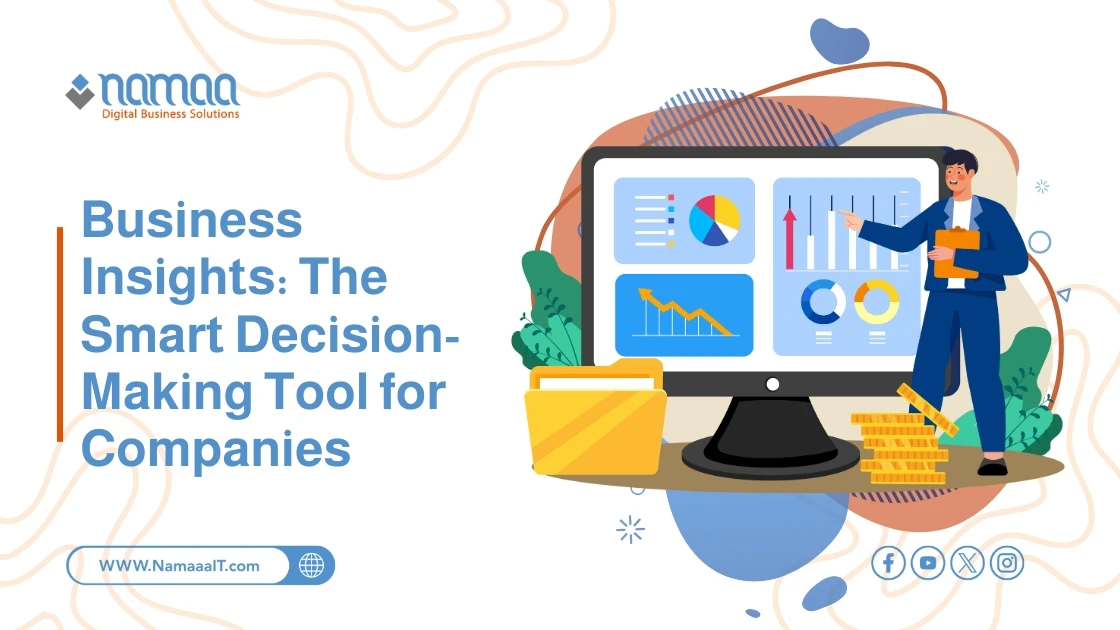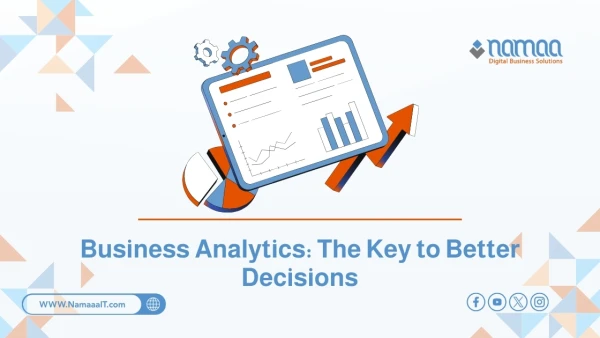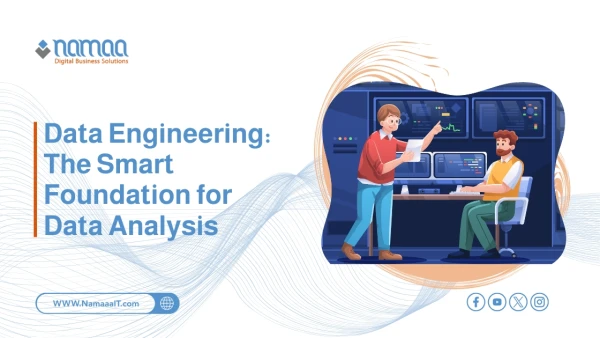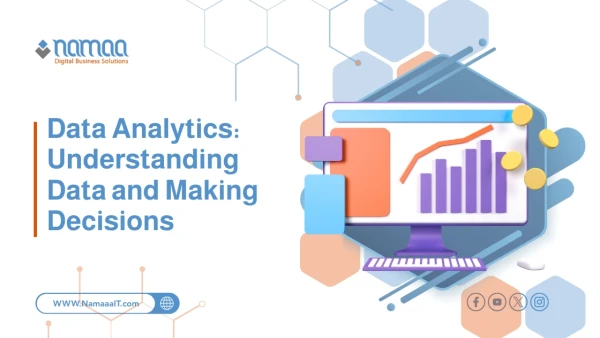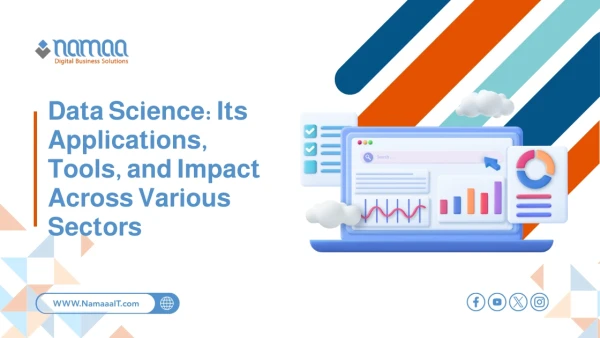Business Insights have today become one of the most critical tools companies rely on to make well-studied strategic decisions.
In a fast-changing, highly competitive business environment, raw data alone is no longer sufficient; it is the ability to analyze this data and extract actionable insights that distinguishes successful companies from others.
Through data analysis, companies can identify emerging trends, understand customer behavior, discover new growth opportunities, and improve operational efficiency. For example, Business Insights may reveal a decline in sales in a particular region not due to economic conditions, but because of shifts in customer preferences or weaknesses in marketing campaigns.
In this article, we will explore the importance of Business Insights in supporting decision-making, explain how companies can leverage them to achieve a competitive advantage, and highlight the tools and methods that help transform data into effective strategic insights.
What Are Business Insights?
Business Insights refer to the deep understanding derived from data analysis, which helps make informed decisions that support growth and enhance performance.
Business Insights are not just about presenting numbers or results; they involve linking those numbers to their practical context and interpreting them to uncover why something is happening and what can be done about it.
For example, analyzing a decline in sales in a specific region isn't just about recording the numbers — it’s about interpreting the cause, such as weak advertising campaigns or changing customer behavior. This is the essence of insights.
These insights may be extracted from Analytical Reports, Interactive Dashboards, or Predictive Analytics technologies.
Companies use Business Insights to understand internal performance, customer needs, and competitor movements, which strengthens their ability to make evidence-based decisions instead of relying on guesswork or intuition.
Insights can be Quantitative (like conversion rates or profits) or Qualitative (like customer satisfaction or brand reputation). The most important factor is that the insights must be Actionable and serve clear goals.
In a rapidly changing environment, Business Insights are an indispensable strategic tool for any organization seeking to survive or excel in the market.
The Difference Between Data, Information, and Insights
Understanding the distinction between Data, Information, and Insights is essential for companies aiming to make intelligent decisions.
Data is raw, unprocessed figures — for example, the daily number of website visitors or units sold. On their own, these numbers don’t mean much.
When data is organized and presented in context — like "sales increased by 15% in the last quarter" — it becomes Information. But even then, it only describes what happened, without explaining the reasons or suggesting next steps.
Insight begins when we ask: Why did this happen? and What should we do about it?
Insight is the result of analyzing and interpreting information to uncover patterns, relationships, and opportunities.
For example, analyzing user behavior on a website may reveal that most visitors leave from a specific page, indicating that page as a weak point needing improvement — this is insight.
You can think of the process as a transformation chain:
Data is processed into Information, which is then interpreted to produce Insights.
Understanding this sequence helps teams know what to focus on and where to start to improve their strategies and plans.
Why Do Companies Need Business Insights?
Companies can no longer rely solely on intuition or past experiences.
Business Insights provide a rational foundation for any decision and give management a realistic ability to predict the future and adapt to changes.
Companies depend on these insights to:
Reduce risks
Improve efficiency
Increase Return on Investment (ROI)
For example, instead of launching a random marketing campaign, a company can analyze target audience behavior and choose the best timing and platform for promotion.
Insights also uncover opportunities that weren’t obvious before.
Through trend analysis and forecasting, managers can anticipate challenges before they occur, discover new markets, or target previously untapped customer segments.
Even at the operational level, insights can reveal supply chain inefficiencies or recurring customer service issues.
In short, Business Insights enable companies to be proactive rather than merely reactive.
A data-backed strategic vision leads to faster decisions, fewer mistakes, and sustainable growth.
In a market that punishes slow or random companies, smart insights become the true success factor.
The Role of Data Analysis in Transforming Data into Insights
Analysis is the bridge between raw data and practical understanding.
Numbers alone don’t tell a story.
Analysis processes those numbers, uncovering what lies beneath.
For instance, low sales in a particular month mean little without understanding why: Is it a seasonal downturn? Have buying habits changed? Was there an ineffective marketing campaign?
Good analysis connects variables, identifies patterns, and contextualizes the results to support decision-making.
There are different types of analysis for different purposes:
Descriptive Analysis explains what happened.
Diagnostic Analysis investigates why it happened.
Predictive Analysis forecasts what might happen.
Prescriptive Analysis recommends what actions should be taken.
Each level adds more depth. The key is to use analysis to serve a clear purpose — not just to produce numbers for the sake of numbers.
Without analysis, data remains meaningless figures.
However, not all analysis generates real insights.
True insights arise when results are linked to context, the right questions are asked, and superficial explanations are avoided.
The difference between effective and ineffective analysis?
Effective analysis leads to action.
Ineffective analysis just adds noise.
Common Analytical Tools for Business Insights
Visual tools like Power BI, Tableau, and Google Looker Studio allow companies to transform dull spreadsheets into interactive dashboards that reveal trends and anomalies.
Predictive analytics often relies on tools like RapidMiner or IBM SPSS, used to predict future outcomes based on past patterns.
However, not all tools are created equal:
Some are excellent for analyzing huge data volumes.
Others are better for creating quick, easy-to-understand visualizations.
Good tools mean little without genuine understanding.
The important thing is to match the tool with the intended use:
Are you aiming to understand customers?
Track performance?
Predict sales?
Each goal requires different tools and specific approaches.
These tools help connect the dots, but they don't think for you.
The real value comes from how you use the results.
Analysis is not the end — it's the beginning of action.
A good analytical tool provides clarity.
A smart decision comes from a team that knows what to do with that clarity.
Business Insights and Consumer Behavior
Understanding consumers requires more than tracking sales figures or engagement rates.
You need to dive deeper into the motivations and factors behind purchasing decisions — this is where Business Insights play a crucial role.
By analyzing data such as purchase history, browsing time, visit frequency, and even cart abandonment patterns, companies can understand what customers truly want, not just what they bought.
Business Insights reveal preferences, obstacles, and critical moments in the buying journey — helping companies design more accurate customer experiences.
Leveraging these insights doesn’t stop at sales.
They can be used to:
Adjust pricing strategies
Develop marketing messages
Personalize campaigns
Even create new products to meet unmet needs.
Deep analysis can also reveal differences between customer segments, allowing tailored content and engagement across various channels to speak directly to each audience’s behavior and language.
Success doesn’t come from guessing — it comes from listening to what the data tells you about your audience.
A precise vision of consumer behavior puts companies in a stronger position to meet — or even exceed — customer expectations.
Performance Forecasting through Business Insights
A clear vision of the future is not a fantasy but the result of intelligent analysis of the past and present. Forecasting performance using business insights gives companies a strong competitive advantage. By tracking past trends, market fluctuations, and consumption patterns, models can be built to predict sales outcomes, demand, and even operational variations. These forecasts are not based on intuition but on systematically collected data.
Forecasting tools such as Machine Learning and statistical models based on historical data are used to create realistic scenarios for the next steps. For example, a model may show that a certain product category experiences seasonal demand, or that marketing campaigns launched on Thursdays generate better returns. These are not assumptions, but outcomes based on thorough analysis.
Accurate forecasting does not mean avoiding all obstacles, but it reduces surprises. The sales team knows where the market is heading. Inventory is managed more efficiently. Marketing campaigns are launched at the perfect time. All of this results from a deep understanding of market movement through insights. And it’s not just about numbers — it includes analyzing social, economic, and even psychological factors influencing general behavior. Effective forecasting turns uncertainty into manageable scenarios.
The Role of Insights in Supply Chain Management
The supply chain is not just about shipping and storage — it’s an interconnected network of processes that can be affected by even the slightest disruption. Business insights make the difference here. By tracking data related to inventory, suppliers, delivery times, and transportation costs, weaknesses can be identified, and efficiency can be improved. Insights reveal what is hidden beneath the surface: repeated delays from a particular supplier, overstocking of slow-moving products, or regions with high logistical costs.
Advanced analytics can provide accurate demand forecasts, enabling companies to plan shipments and inventory to avoid waste or shortages. It can also detect connections between seasonal events and supply disruptions, helping companies take proactive measures instead of reacting too late. Good visibility means anticipating pressure before it happens and having the flexibility to adjust plans immediately when needed.
Any disruption in the supply chain can cost a company its reputation even before its profits. Using business insights in this area helps build a more stable and adaptable supply chain. Every supply chain decision — from supplier selection to delivery scheduling — becomes closer to precision and further from improvisation. Here, insights not only reduce risks but also increase overall performance reliability.
The Role of Artificial Intelligence in Business Insights
Artificial Intelligence (AI) has become a cornerstone in the development of business insights because it doesn’t just analyze data — it learns from it and interacts with it. Using techniques like Machine Learning and Natural Language Processing (NLP), AI can mine massive amounts of data quickly and efficiently, extracting patterns and behaviors that would be difficult for humans to detect. These capabilities enable companies to gain deeper and more accurate insights without relying on manual analysis or traditional assumptions.
In practical terms, AI is used to predict market trends, identify growth opportunities, improve customer experience, and even detect risks early. For example, it can analyze customer reviews to understand their true sentiments or predict a drop in demand for a product based on slight changes in purchasing behavior. AI also streamlines decision-making by providing real-time, data-driven recommendations.
The advantage of AI lies not only in speed or accuracy but in its ability to continuously learn. Every interaction and update feeds the system with more knowledge, making insights even more sophisticated over time. However, the success of AI in business insights doesn’t depend solely on the tool itself but on how it’s integrated into the business strategy. Without a clear goal and practical context, algorithms remain just lines of code. But when used intelligently, they become an extra mind in the decision-making room.
Summary:
✅ 70% of major companies rely on data analytics for strategic decision-making.
✅ Business insights are defined as deep understanding based on data analysis, used to improve decisions and identify trends.
✅ The difference between data, information, and insights: Data is raw, information is organized, and insights are actionable.
✅ Effective analysis transforms data into insights using descriptive, diagnostic, predictive, and prescriptive analytics.
✅ Common analytics tools include: Power BI, Tableau, Google Looker Studio, RapidMiner, and IBM SPSS.
✅ 83% of marketers use consumer behavior insights to personalize advertising messages.
✅ Performance forecasting through business insights improves sales planning, budget management, and risk reduction.
✅ Supply chains powered by insights see a 15% cost reduction and a 20% decrease in delivery times.
✅ Artificial intelligence enables the rapid analysis of big data, real-time recommendations, and continuous learning.
✅ Companies that rely on business insights grow 5 to 6 times faster than those relying on intuition.

